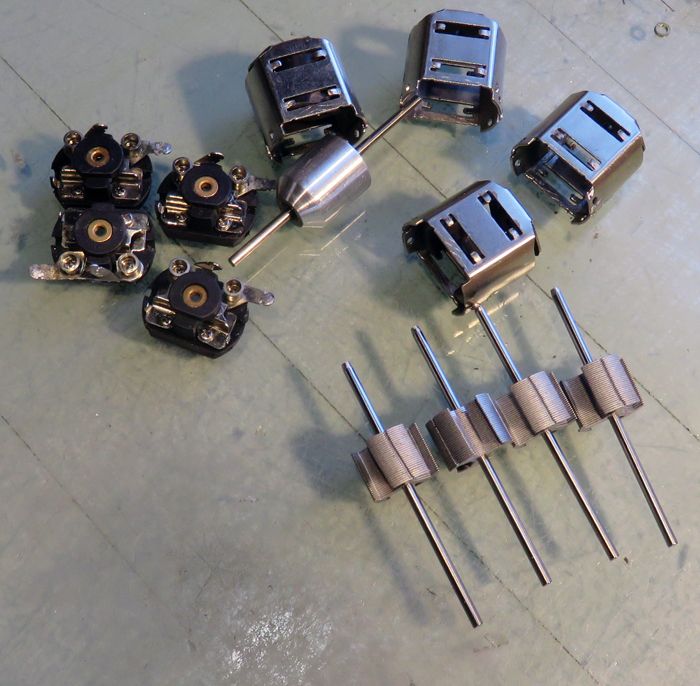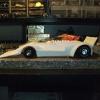Apologies to Charles Dickens, but coming up with catchy thread titles gets difficult without recycling my own... especially when I've done so many I can't remember whether I'm repeating myself or not.
Anyway, it seems the little guys (both the PS and Hawk types) are popular and can also benefit from a little TLC... once those pesky seals come off. ![]() So, here's a group of four that I'll build and wind, three with the "poly neos" and one with the ceramics. I won't be doing anything crazy, just going over them and building them according to what I figure should be done to wind up with solid and reliable motors. They're good right out of the box, but I like to think I can make them better and still have them be affordable.
So, here's a group of four that I'll build and wind, three with the "poly neos" and one with the ceramics. I won't be doing anything crazy, just going over them and building them according to what I figure should be done to wind up with solid and reliable motors. They're good right out of the box, but I like to think I can make them better and still have them be affordable.
Right away, all of them got taken apart, the armatures tossed (the arms all had been balanced, so reusing the stacks with new shafts wasn't happening here), and the magnets removed. Before prying up those can clips and getting the magnets free from whatever that glue is that holds them, I checked the "holes" and they vary by quite a bit. That might be at least part of why performance can vary with these things, but is besides the point here. All of them will get the magnets reset and epoxied-in with the same slug for a little more consistency. First thing here was to clean the glue off the magnets and the insides of the cans' mating surfaces. I also built and pressed the four stacks so they can now be spaced and powder-coated. Three of the four motors had nice can bushings that were still tight, and one needed a new one. I took care of that right away.
The endbells will need some work straightening the hardware and cleaning things up, but the endbell bushings seems like the main issue with these. Like the Hawk, the bushings here tend to be loose. When you take apart these things, the bushings can inadvertantly just come out with the armature. That makes me think it's at least possible for the bushings to get to the point where they can rotate while the motor is under load and spinning. On these motors, there's even less material to drill so the bushings can be bonded to the endbell, but I'll cross that bridge when I come to it

A tale of four mini-cans
#1

Posted 30 March 2017 - 01:50 PM
- Cheater, slotbaker, MSwiss and 6 others like this
#2

Posted 31 March 2017 - 04:02 AM
John, I'm following this with interest!!
- havlicek likes this
Steve Meadows
#3

Posted 31 March 2017 - 07:15 AM
Hi Steve,
What I hope comes through here is not that I am carping about motors that are, after all, a really good value and present some impressive performance capabilities. I won't be doing a hot rewind project here, because that isn't what people normally use these for. Right now, my plan is just to tighten-up the setups (and even that won't involve anything but really normal motor tweaking that about anyone could do with no special tools or knowledge), and wind a 65t/30 arm with moderate timing advance. After spacing and installing the arm, the end result should be a motor that behaves more predictably and performs reliably.
I like these motors. I think a modern C-can motor is a way better platform for general building, running and racing (the best platform), but since these motors are popular, they make an obvious choice for this sort of thing.
Apparently, there are some rule sets that allow for unsealed versions of these motors running un-tagged arms, so this stuff would be most appropriate for people racing these motors under those conditions.
- Alchemist likes this
#4

Posted 31 March 2017 - 09:40 AM
I hadn't thought much about it until I read your post, John, but you are absolutely right. The modern C-can platform is far and away the best overall motor, so why is it avoided in so many cases? It has been around longer, many can/magnet and armature options exist, it is simple to build, so what gives? Why do people race minis and D-cans at all? (I am not going to touch the FK thing at all).
All I can think of is that many of the C-can guys essentially priced themselves right out of the market. If you look at the Cahoza, Koford, and Red Fox stuff, they are all comparatively more expensive. Pro Slot has some good entry-level products, but they might be a little heavier. So maybe it's the usual case of racers being racers.
D-cans I don't get at all any more. Why race them other than I have a big pile of them?
So minis are an inexpensive, buildable, good-handling option, and provide a lot of bang for the buck. That's my best guess.
- havlicek, Samiam and Kevin Donovan like this
#5

Posted 31 March 2017 - 09:57 AM
Hi Dave,
All of these motors (minis, C and D-can motors) are of the exact same general type. They all have a folded and formed can welded at the seams, they all have a plastic endbell that is both a very good insulator and heat-resistant enough for almost all motor types and winds. There is absolutely no reason why the C-can motors should be any more expensive than either of the other two. The C has more room for building the motor and winding the arm... not to mention better cooling, and of course is suitable for anything from the mildest #30 winds all the way up to the big wire stuff. There are plenty of parts for building C-can motors as well. Personally, I like the Mura and RJR stuff, but I realize that many see those as "not the latest and greatest."
Anyway, we're getting a little sidetracked here. The minicans are here, they're very popular, so I figure I should get busy!
- Alchemist likes this
#6

Posted 31 March 2017 - 11:41 AM
What is the "smallest" of these PS motors called? How do they compare to the FK motors?
#7

Posted 31 March 2017 - 11:47 AM
These and the Hawks are the smallest can motors with a regular removable endbell used for slot racing, and are both generally referred to as "FK" (a size designation). They still use a normal diameter stack (in the .510-.515" neighborhood), but at a shorter length. Normal width comms in these motors will not fit unless the hardware has been opened up a little on the inside.
#8

Posted 31 March 2017 - 12:16 PM
Pro Slot calls them a Euro MK1, 4000 series.
- olescratch likes this
"If you have integrity, nothing else matters, and if you do not have integrity, nothing else matters."
Robert Mueller, special counsel (2013)
"... because people have got to know whether or not their president is a crook."
Richard M .Nixon, Nov 17, 1973
"Fool me once, same on... shame on you. Fool me... you can't get fooled again."
George W. Bush
#9

Posted 31 March 2017 - 01:58 PM
Hi John,
Nice project, I bet this will reveal some very interesting results.
Do you still use your two-handled wood clamp to press the stack of lams on the shaft?
Do you use Duralco 4461 to epoxy the compressed and aligned stacks prior to powder coating?
Thanks,
g
- havlicek and Alchemist like this
Yes, to be sure, this is it...
#10

Posted 31 March 2017 - 02:07 PM
Boy, you just reminded me of stuff I hadn't done for a long time. I've been using a cheap arbor press to press the lams, along with a couple of small mods for the task and a little side-gizmo for years now.
There's no need to use epoxy on the stacks prior to powder coating unless you're reusing old lams that have "lost their grip" on the shaft. Mabuchi lams are particularly suceptible to this when you try and reshaft them. Mostly, the stack will simply fall apart on the new shaft, so you need to do something to hold it all together while you press out the old shaft and press in the new one.
It can happen even if you're just changing where the stack is on the same shaft... as in making an endbell drive arm into a can drive arm.
- Alchemist and Geary Carrier like this
#11

Posted 31 March 2017 - 02:23 PM
What is the "smallest" of these PS motors called? How do they compare to the FK motors?
Isn't the Hawk 6 even smaller than the PS motors, and has a removable endbell?
Cheers.
Bill Botjer
Faster then, wiser now.
The most dangerous form of ignorance is not knowing that you don't know anything!
Never attribute to malice that which is adequately explained by stupidity
#12

Posted 31 March 2017 - 02:58 PM
Sorry John H., seems like I may have caused a slight "drift" in the topic. But seems like others have issues identifying these things. I would also like to see a pic of the lam pressing equipment you are using. The one attempt that I made trying to convert an endbell drive into a can drive resulted in a bent shaft/arm!
- havlicek and Alchemist like this
#13

Posted 31 March 2017 - 02:59 PM
Isn't the Hawk 6 even smaller than the PS motors, and has a removable endbell?
Nope, same size as the PS mini-cans.
- havlicek likes this
Steve Meadows
#14

Posted 31 March 2017 - 03:16 PM
Sorry John H., seems like I may have caused a slight "drift" in the topic. But seems like others have issues identifying these things. I would also like to see a pic of the lam pressing equipment you are using. The one attempt that I made trying to convert an endbell drive into a can drive resulted in a bent shaft/arm!
Once lams have been pressed, they will only "want" to move in the same direction as they had been originally pressed... think of "Chinese handcuffs". They *can* move in the other direction, but it will be much harder. When you try and press a shaft out... or to just move it, try increasing amounts of pressure on either end until you find out which way it will move. The "equipment" I use is one of these ![]() , but it was on sale when i got it and was about half the price. I lowered the ram and scribed its outline on all the work surfaces, then I drew corner-to-corner lines on those squares to find the center and drilled out those so a shaft could easily fit. I also removed the ram and found the center, drilling a little dimple there to help locate the arm shaft. Since these things don't have a positive stop or detente at each possible position, none of this will register in the "X" axis, but will keep things close enough in the "Y" axis. The slots between the flats also work for some other "pressing" matters!
, but it was on sale when i got it and was about half the price. I lowered the ram and scribed its outline on all the work surfaces, then I drew corner-to-corner lines on those squares to find the center and drilled out those so a shaft could easily fit. I also removed the ram and found the center, drilling a little dimple there to help locate the arm shaft. Since these things don't have a positive stop or detente at each possible position, none of this will register in the "X" axis, but will keep things close enough in the "Y" axis. The slots between the flats also work for some other "pressing" matters!
- Lee Palmer and Geary Carrier like this
#15

Posted 31 March 2017 - 03:17 PM
Nope, same size as the PS mini-cans
What Steve said! ![]()
#16

Posted 31 March 2017 - 03:24 PM
Got some more done on these things.
First though, I thought about it and decided to make it two ceramic magnet versions and two poly-neo versions, swapping out one the the cans. Endbells have been stripped to get ready to do something about the loose bushings, and so I could straighten and clean the hardware. Also, these will need to have clearance checked and (when necessary) increased for the new comms. The magnets have been epoxied-in to the cans at the same fore/aft positions as determined by the stop tabs at the rear of the cans, but with the ceramics set to a a little tighter hole than the neos, to even up things just a bit.
The arms have been built and spaced, with the powdercoat removed from the outside of the stacks, with the comms installed and timed to approximately 18 degrees advance CCW. I also slightly shortened the comms slightly where it doesn't affect their strength or function, but still leaving them near full-length. I found that one more of the can bushings is loose, so I'll epoxy all of them in to be sure they stay put.
- C. J. Bupgoo and Geary Carrier like this
#17

Posted 31 March 2017 - 03:29 PM
OK! That's similar to the press I used. What I didn't do was the centering of the ram to the base using drilled holes in each (something to do before trying it again).
#18

Posted 31 March 2017 - 03:39 PM
I was going to share with you my modified C-can tool that I used when I did some playing around with these.
Start with one of THESE.
Use (your new) lathe to turn down to right size
Drill some holes so as no to damage motor holding threads or bushing if in place.

Then start panelbeating...
Steve Meadows
#19

Posted 31 March 2017 - 05:11 PM
Why would you use a can mandrel for pressing lams onto a shaft? Or did I miss something?
#20

Posted 31 March 2017 - 05:29 PM
I think Steve is showing a device that could be used without taking the arm from the can!! That would be the only need for drilling holes to prevent damage to the motor mounting holes!
I never even thought of trying it this way, and will never! BTW, what is panel beating?
#21

Posted 31 March 2017 - 06:34 PM
#22

Posted 01 April 2017 - 07:20 AM
- havlicek, NSwanberg and Jesse Gonzales like this
Gregory Wells
Never forget that first place goes to the racer with the MOST laps, not the racer with the FASTEST lap
#23

Posted 01 April 2017 - 08:02 AM
That's what I 'figgered," Greg, thanks for the confirmation!
#24

Posted 01 April 2017 - 08:09 AM
Got the arms wound, so now it's time for "finishing" (welding, tieing and epoxying) and then some last length-tweaking to be sure there's enough space to center the arms with washers, before sending them out for grinding and balancing.
After all that, I can start working on the endbells. That way, when the arms come back from balancing, there's just a final assembly to take care of... usually only about 15-20 minutes per motor... if... I didn't miss something before, or if something just pops up!
Even if you take all the armature work out of the equation, you're probably still looking at somewhere between two-three hours of work per motor. On the more "custom" stuff, that figure goes waaaaay up. Funny thing is, the time doesn't really change whether you're starting with a brand new motor or not.
Anywho... more pictures to follow.
- Lee Palmer likes this
#25

Posted 01 April 2017 - 12:14 PM
... I also slightly shortened the comms slightly where it doesn't affect their strength or function, but still leaving them near full-length.
When you shorten comms, is there a preferred end for material removal, or do you take it off both ends?
Back in the day when I was building shorty C-cans for 1/32 racing, I'd shorten the spacer to where the underside of the comm would just clear the windings, then skim cut the bearing end of the comm. Group 12 blanks with .350" stack length. I used a vertical wet belt sander (silicone carbide belt) to shorten the mags (cut to .400" long) with chip-free super smooth results, and cut the end bell end of the can to where the arms would just fit.
The rules at the time mandated a 2.5" max. car width – with my stubby motors I was able to have shallow anglewinder chassis with decent tire width. One 26 ga. 26t arm was equal down the straight of our 220' Engleman with the best of the current Grp. 7 1/24 cars. It shocked all the go-fast racers (including myself!), but proved to be too much of a handful on the tight 1/32 home tracks. But it definitely kicked booty on the one 150' commercial track that was part of the series that year.
- MarcusPHagen likes this
5/26/??-9/12/17
Requiescat in Pace





















